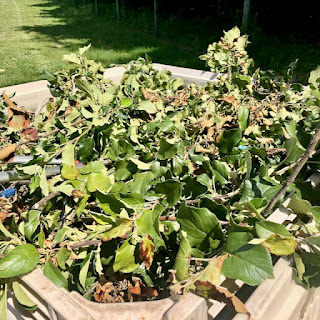 |
| Blossom blight on newly planted NY-1 apple tree |
First up, this year's planting of NY-1 (sold as SnapDragon®) apples. Serious fire blight taking out significant portions of the leader, maybe up to 50% of trees planted. Sorry sight. Conversation with grower:
Grower: "Did it come in from the nursery?"
Me: "Nursery will deny it and in reality you have a mature apple block next door with a history of fire blight and these affected trees had a lot of bloom, right? Did you remove the bloom or spray streptomycin during bloom?"
Grower: "No on removing the bloom, but I did spray strep once, and there was no rain when they were in bloom."
Me: "Yea but I checked NEWA and indeed the fire blight risk was high to extreme and it does not take much wetting, for example airblast spraying or heavy dew, to spread the blight around and cause infection."
Grower "Oh, now what can I expect?"
Me: "Well you are cutting the fire blight out during dry weather to the best of your ability, it is a shame given many trees have significant part of the leader with blight, and some trees will have to be removed completely. And you will continue to see more blight after you think you have it all cut out. You should probably also spray copper as often as feasible, that will help reduce the spread. And next year be on top of bloom with strep sprays when the fire blight risk is high. Hopefully infection will subside now which is usually what happens after the initial outbreak, but it won't go away unfortunately."
Grower: "But I still think it came in from the nursery :-)"
OK, questions lingering in my mind after departing the orchard. Is SnapDragon® particularly susceptible to fire blight? I know for a fact it's sister NY-2 (sold as RubyFrost® apples) is very susceptible. And a couple other adjacent just-planted varieties (MAIA apples) had some, but not nearly as much, fire blight. And, I know there are other recommendations out there to help prevent further spread in young trees, what are those? Double Nickel and Cueva? Actigard and Prohex-Cal (Apogee/Kudos)? But of course I did not remember the details.
Second, another new planting, this time MAIA-1 (sold as Evercrisp® apples), orchard crew in the middle of once again cutting it out. Enough to be time consuming, will never get it all, and in some cases the whole leader blighted. Ugh. Was not easy to elicit whether strep sprays had been applied, maybe just once? Now I was getting mad after seeing this twice in one week, and it seems to me this could have been prevented? Or maybe not given the fact this new apple planting was adjacent to a block of cider apples! Now there is double trouble if I ever saw it! A history of fire blight in this cider block, of course. Found some blight over there right now, Dabinett, Stokes Red had more than most of the others. It's just not a good idea planting a new apple orchard next to a cider apple block! (Is it a good idea to plant cider apples period? I am beginning to wonder...)
 |
| Shoot blight (likely originated from blossom) of 1st-leaf MAIA-1 apple tree |
 |
| Bin full (literally) of fire blight prunings |
 |
| Fire blight in cider apple (Dabinett or Stokes Red) |
OK. What could have and should be done to prevent or reduce fire blight infection on these 1st-leaf trees:
- Manual removal of bloom. I know, it is time consuming but probably the number one thing you can do to prevent blossome blight infection. Usually requires several trips, every other day or so through the orchard to get all the bloom. I just clip the flower petals off at the pedicels with scissors or similar.
- Lacking bloom removal, frequent strep and copper sprays, as recommended by consultant Win Cowgill. Copper beginning at bud break, your choice of product at moderate rate. Streptomycin beginning when first blooms open and continuing every 2-3 days as bloom opens. Need several (many?) strep sprays to keep up with open bloom. Until it is done. Strep probably not necessary if it is absolutely dry and there is no risk of fire blight infection predicted by the models, but that is rare. I know there are peaches to prune and vegetables to plant but you need to find time to do this! And think about coverage, there is not much tree there, turn off the fan, go slow, make sure you are getting good coverage and not blowing your spray all over the place!
- If you are not successful with above, yes, cut out the fire blight. In dry weather. Does not hurt to sterilize pruners between cuts unless it signficantly hinders speed of fire blight removal. Goal should be to get it out of there ASAP. Remove prunings well away from orchard if possible, otherwise put in middle, let dry out for a few days, and mow. Always during dry weather.
- After pruning, it looks like the best option to prevent further shoot blight are regular applications (every 1-2 weeks?) of Double Nickel (a biofungicide) and Cueva (a low rate copper). There are other "biologicals" out there, but the Double Nickel/Cueva option seems to have the most mentions and has proven to be the most effective at preventing shoot blight. Kari Peter at PSU has a good review of these options here. (I wonder about Oxidate? Couldn't hurt.) And oh yes, a strep application if a trauma event -- rain with high wind and/or hail -- occurs.
Finally, be on top if it next year. George Sundin at MSU recommends Actigard with Prohex-Cal on young trees (2nd and 3rd-leaf) at high risk for fire blight. And strep during bloom when the fire blight warning flag gets hoisted is still your best friend.